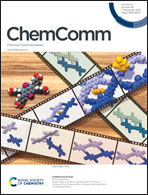An activatable near-infrared fluorescent probe facilitated high-contrast lipophagic imaging in live cells†
Abstract
A new fluorescent probe (Q-lipo) was developed by conjugating a xanthene scaffold with a quinoline moiety for activatable imaging of lipophagy. Q-lipo with acidic pH activated near infrared fluorescence and the lipid droplet targeting ability allowed activatable fluorescence imaging and flow cytometry detection of lipophagy in live cells with high contrast. It was further utilized to study the effect of tumor-microenvironment related conditions on lipophagy. Q-lipo would provide a useful tool for studying lipophagy in live cells.



 Please wait while we load your content...
Please wait while we load your content...